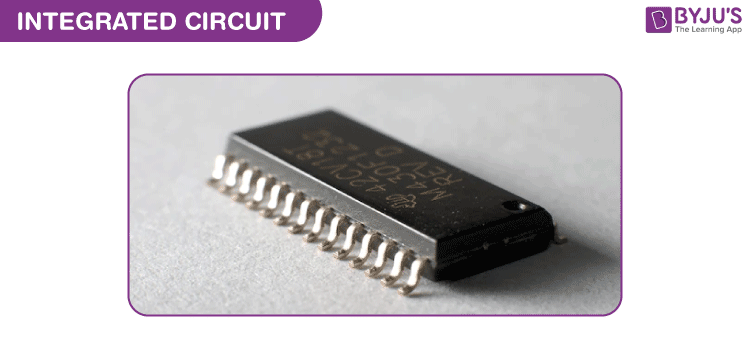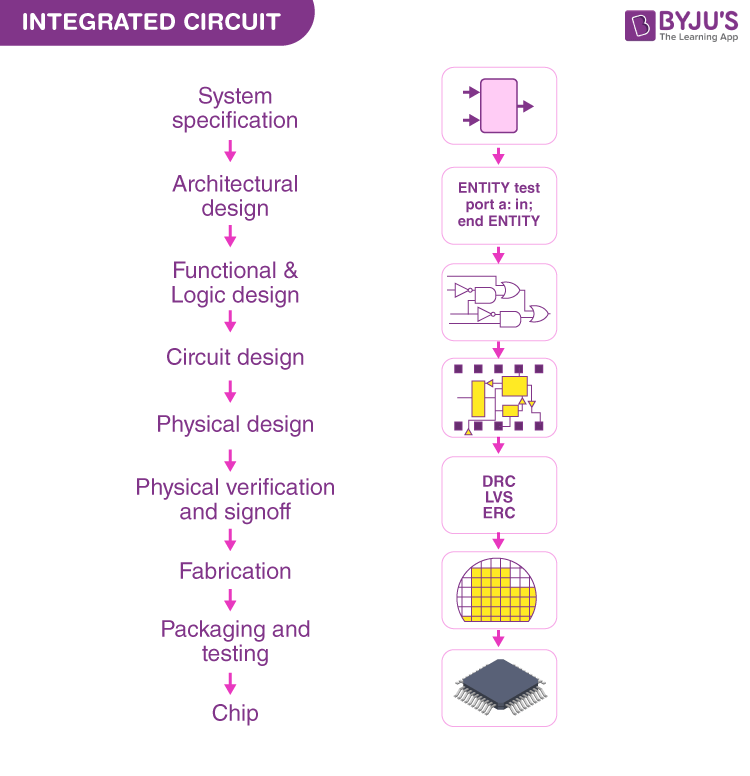The conventional method of making circuits was to select components like R, C, L, diode and semiconductors. There are so many factors stopping to build off big circuits like:
1. Bulky in size.
2. Not entirely shockproof
3. Reliability
4. More power consumption
5. Less durability
The concept of fabricating an entire circuit on a single small block (or chip) of a semiconductor has revolutionised electronics technology. Such a circuit is known as Integrated Circuit (IC). In this article, let’s study IC.
| Table of Contents |
What is an Integrated Circuit (IC)?
Before the discovery of ICs, the basic method of making circuits was to select the components like diodes, transistors, resistors, inductors and capacitors and connect them by shouldering. But due to size and power consumption issues, it was necessary to develop a small size circuit with less power consumption, reliability and shockproof.
After the invention of the semiconductors and transistors, things were quite simplified to a particular extent, but the development of integrated circuits changed electronics technology’s face. Jack Kilby from Texas Instruments and Bob Noyce from Intel are the official creators of integrated circuits, and they did it independently.
The integrated circuit is a fundamental concept of electronics that builds on other basic concepts previously discussed in our syllabus. Therefore, for a quick reference, go through the articles listed below:
Definition of Integrated Chip
Integrated circuits are made up of several components such as R, C, L, diodes and transistors. They are built on a small single block or chip of a semiconductor known as an integrated circuit (IC). All of them work together to perform a particular task. The IC is easily breakable, so to be attached to a circuit board, it is often housed in a plastic package with metal pins.

Integrated circuits can function as an oscillator, amplifiers, microprocessors or even as computer memory.
Integrated Circuit Design
An integrated circuit is created using certain logic methods and circuit layouts. The two categories of IC design are as follows:
- Analog Design
- Digital Design
- Mixed Design
Digital Design
The digital design approach is used to create integrated circuits (ICs), which are utilised as computer memories (such as RAM and ROM) and microprocessors. With this approach to design, the circuit density and overall efficiency are both maximised. The ICs created with this technique operate with binary input data like 0 and 1. The process for designing digital integrated circuits is depicted in the diagram below.

Analog Design
IC chip is created by using the analogue design process when:
- ICs are utilised as regulators, filters and oscillators.
- Optimal power dissipation, gain and resistance are required.
Mixed Design
The analog and digital design ideas are used in mixed designs. The mixed ICs perform either Analog to Digital or Digital to Analog conversions.
Integrated Circuit Construction
A complicated stacking of semiconductors, copper, and other related elements to create resistors, transistors, and other components is an integrated circuit. A die is a combination of these wafers that have been sliced and moulded.
The ICs’ semiconductor wafers are delicate, and the connections between the layers are extremely complex. The ICs are packaged because an IC die is too small to solder and connect to. The delicate and tiny die is transformed into the familiar black chip by the IC packaging.
The connections between the layers are exceedingly complicated, and the semiconductor wafers used to make the ICs are delicate. Because an IC die is too small to solder, the ICs are packed.
All integrated circuits (ICs) are polarised, and each pin has a specific location and functionality. As seen in the illustration below, integrated chips employ a notch or a dot to denote the first pin.
The subsequent PINs rise consecutively in a counterclockwise way around the chip after the first pin is identified.
Integrated Circuit Features
Construction & Packaging
ICs are built with semiconducting components such as silicon. Because of the small size and delicate nature of IC, a series of tiny gold and aluminium wires are joined together and moulded into a flat block of plastic or ceramic. Metal pins on the block’s exterior link to cables inside. The solid block stops the chip from overheating and keeps it cool.
Size of an IC
The size of the integrated chip varies between 1 square mm to more than 200 mm.
Integration of an IC
Because they combine various devices on one chip, integrated chips get their name. A microcontroller is an integrated circuit (IC) that combines a microprocessor, memory, and interface into a single unit.
Commonly Used ICs
Logic Gate ICs
The combinational circuit generates logical outputs based on a variety of input signals. It may only have two to three inputs but one output.
Timer ICs
A Timer IC is produced with accurate timing cycles with a 100 % or 50 % duty cycle.
Operational Amplifiers
An OpAmp or an Operational Amplifier is a high gain voltage amplifier with a differential input and a single-ended output.
Voltage Regulators
A voltage regulator IC provides a constant DC output irrespective of the changes in DC input.

Comments